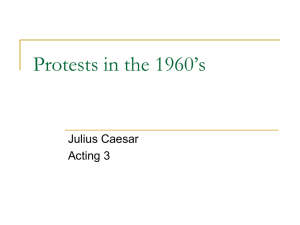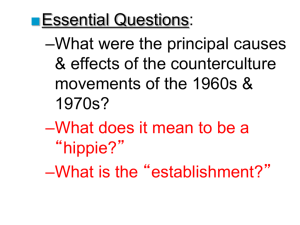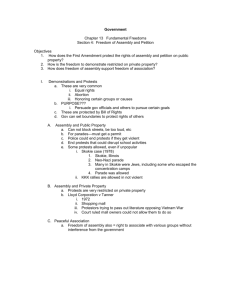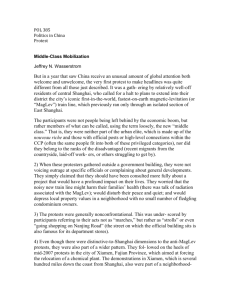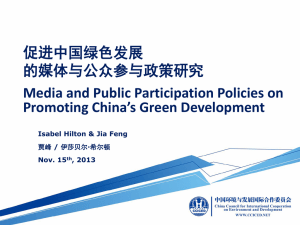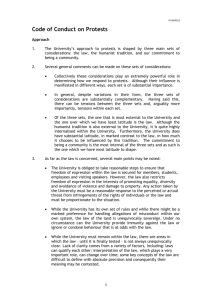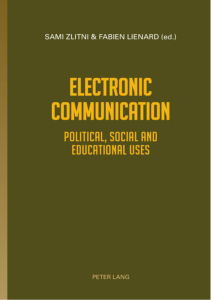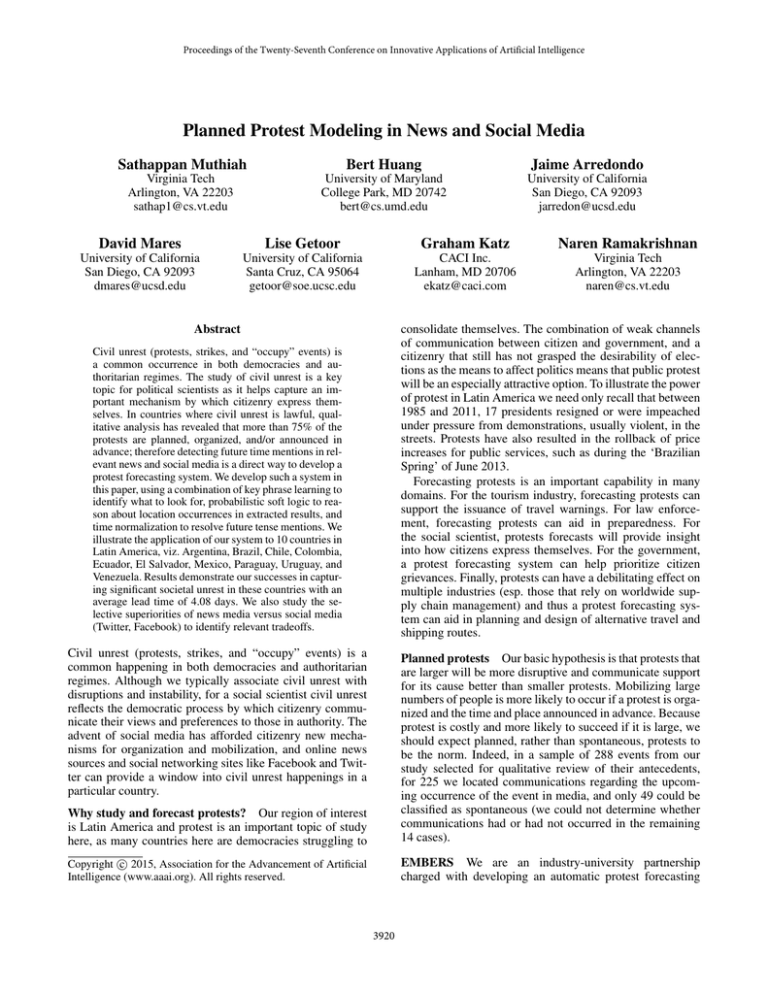
Proceedings of the Twenty-Seventh Conference on Innovative Applications of Artificial Intelligence
Planned Protest Modeling in News and Social Media
Sathappan Muthiah
Virginia Tech
Arlington, VA 22203
sathap1@cs.vt.edu
David Mares
University of California
San Diego, CA 92093
dmares@ucsd.edu
Bert Huang
University of Maryland
College Park, MD 20742
bert@cs.umd.edu
Lise Getoor
Graham Katz
University of California
Santa Cruz, CA 95064
getoor@soe.ucsc.edu
CACI Inc.
Lanham, MD 20706
ekatz@caci.com
Abstract
Jaime Arredondo
University of California
San Diego, CA 92093
jarredon@ucsd.edu
Naren Ramakrishnan
Virginia Tech
Arlington, VA 22203
naren@cs.vt.edu
consolidate themselves. The combination of weak channels
of communication between citizen and government, and a
citizenry that still has not grasped the desirability of elections as the means to affect politics means that public protest
will be an especially attractive option. To illustrate the power
of protest in Latin America we need only recall that between
1985 and 2011, 17 presidents resigned or were impeached
under pressure from demonstrations, usually violent, in the
streets. Protests have also resulted in the rollback of price
increases for public services, such as during the ‘Brazilian
Spring’ of June 2013.
Forecasting protests is an important capability in many
domains. For the tourism industry, forecasting protests can
support the issuance of travel warnings. For law enforcement, forecasting protests can aid in preparedness. For
the social scientist, protests forecasts will provide insight
into how citizens express themselves. For the government,
a protest forecasting system can help prioritize citizen
grievances. Finally, protests can have a debilitating effect on
multiple industries (esp. those that rely on worldwide supply chain management) and thus a protest forecasting system can aid in planning and design of alternative travel and
shipping routes.
Civil unrest (protests, strikes, and “occupy” events) is
a common occurrence in both democracies and authoritarian regimes. The study of civil unrest is a key
topic for political scientists as it helps capture an important mechanism by which citizenry express themselves. In countries where civil unrest is lawful, qualitative analysis has revealed that more than 75% of the
protests are planned, organized, and/or announced in
advance; therefore detecting future time mentions in relevant news and social media is a direct way to develop a
protest forecasting system. We develop such a system in
this paper, using a combination of key phrase learning to
identify what to look for, probabilistic soft logic to reason about location occurrences in extracted results, and
time normalization to resolve future tense mentions. We
illustrate the application of our system to 10 countries in
Latin America, viz. Argentina, Brazil, Chile, Colombia,
Ecuador, El Salvador, Mexico, Paraguay, Uruguay, and
Venezuela. Results demonstrate our successes in capturing significant societal unrest in these countries with an
average lead time of 4.08 days. We also study the selective superiorities of news media versus social media
(Twitter, Facebook) to identify relevant tradeoffs.
Civil unrest (protests, strikes, and “occupy” events) is a
common happening in both democracies and authoritarian
regimes. Although we typically associate civil unrest with
disruptions and instability, for a social scientist civil unrest
reflects the democratic process by which citizenry communicate their views and preferences to those in authority. The
advent of social media has afforded citizenry new mechanisms for organization and mobilization, and online news
sources and social networking sites like Facebook and Twitter can provide a window into civil unrest happenings in a
particular country.
Why study and forecast protests? Our region of interest
is Latin America and protest is an important topic of study
here, as many countries here are democracies struggling to
Planned protests Our basic hypothesis is that protests that
are larger will be more disruptive and communicate support
for its cause better than smaller protests. Mobilizing large
numbers of people is more likely to occur if a protest is organized and the time and place announced in advance. Because
protest is costly and more likely to succeed if it is large, we
should expect planned, rather than spontaneous, protests to
be the norm. Indeed, in a sample of 288 events from our
study selected for qualitative review of their antecedents,
for 225 we located communications regarding the upcoming occurrence of the event in media, and only 49 could be
classified as spontaneous (we could not determine whether
communications had or had not occurred in the remaining
14 cases).
Copyright c 2015, Association for the Advancement of Artificial
Intelligence (www.aaai.org). All rights reserved.
EMBERS We are an industry-university partnership
charged with developing an automatic protest forecasting
3920
for nearly two years. The end consumers of our alerts are
analysts studying Latin America. Our results demonstrate
that we are able to capture significant societal unrest in the
above countries with an average lead time of 4.08 days.
system for 10 countries in Latin America. Our system,
called EMBERS, has been deployed since Nov 2012 and has
been generating forecasts (called warnings or alerts) automatically, without a human-in-the-loop. These forecasts are
emailed to a third party (MITRE) for evaluation. Analysts at
MITRE organize a reference database of protests (called the
Gold Standard Report, or GSR) by surveying newspapers
for reportings of protests, and compare our warnings against
the GSR to generate a scoring report (evaluation criteria described later).
The full EMBERS system has been described elsewhere (Ramakrishnan et al. 2014), including the overall system architecture, data sources used for analysis, and the various forecasting models in EMBERS. EMBERS adopts a
multi-model approach, wherein different models are leveraged for their selective superiorities to generate a fused set
of alerts. Arguably, one of the best performing models in
EMBERS is the planned protest model that detects ongoing
organizational activity and generates warnings accordingly.
This paper is the first to present this model in detail, including the research issues involved, and how we addressed them
in EMBERS.
Capturing mentions of protest planning and organization
is not as easy as it might appear. First, articles of interest are
written in different languages (Spanish, Portugese, French,
Dutch, and English). Second, multiple locations are often
mentioned in a given article, leading to (natural language)
ambiguity about the intended location of the event. Significant reasoning is required to discern the correct protest location. Finally, dates are often described in relative terms,
e.g., ‘Sunday’ and thus these vague references need to be
resolved into absolute temporal information.
Our detection approach combines shallow linguistic analysis to identify a corpus of relevant documents (articles,
tweets) which are then subject to targeted deep semantic
analysis. Despite its simplicity, we are able to detect indicators of event planning with surprisingly high accuracy. Our
contributions are:
1
Related Work
Five categories of related work are briefly discussed here
(see also Table 1).
Event detection via text extractions is an extensively
studied topic in the literature. Document clustering techniques are used in, e.g., (Gabrilovich, Dumais, and Horvitz
2004) to identify events retrospectively or as the stories arrive. Works like (Banko et al. 2007; Chambers and Jurafsky
2011; Riloff and Wiebe 2003) focus on extraction patterns
(templates) to extract information from text.
Temporal information extraction is another well studied topic. The TempEval challenge (Verhagen et al. 2009)
led to a significant amount of algorithmic development for
temporal NLP. For instance, a specification language for
temporal and event expressions in natural language text is
described in (Pustejovsky et al. 2003). Refs. (Llorens et al.
2012) and (Mani and Wilson 2000) provide methods to resolve temporal expressions in text (our own work here uses
the TIMEN package (Llorens et al. 2012)).
Event forecasting: Radinsky and Horvitz (Radinsky and
Horvitz 2013) find event sequences from a corpora and then
use these sequences to determine if an event of interest (e.g.,
a disease outbreak, or a riot) will occur sometime in the future. This work predicts only if a potential event will happen
given a historical event sequence but does not geolocate the
event to a city-level resolution, as we do here. Kallus (Kallus
2014) makes use of event data from RecordedFuture (Truvé
2011) to determine if a significant protest event will occur
in the subsequent three days and casts this as a classification
problem. This work only focuses on prediction of significant
events (suitably defined) and the forecast is limited to a fixed
time window of the next three days.
Future retrieval: Baeza-Yates (Baeza-Yates 2005) provides one of the earliest discussions of this topic; here future
temporal information in text is found and used to retrieve
content from search queries that combine both text and time
with a simple ranking scheme. Kawai et al. (Kawai et al.
2010) present a search engine (ChronoSeeker) for searching
future and past events. RecordedFuture (Truvé 2011), introduced earlier, conducts real-time analysis of news and tweets
to identify mentions of events along with associated times.
Anectodally it is estimated that approximately (only) 5–7%
of events extracted by RecordedFuture are about the future.
Planned protest detection: Two publications—Compton et
al. (Compton et al. 2013) and Xu et al. (Xu et al. 2014)—
align very closely to our own work as their emphasis is
on protest forecasting. Both works are aimed at forecasting
protests but emphasize different data sources and different
methodologies. For instance, the work in (Compton et al.
2013) filters the Twitter stream for keywords of interest and
searches for future date mentions in only absolute terms, i.e.,
explicit mentions of a month name and a number (date) less
than 31. Such an approach will not be capable of extracting the more common way in which future dates are ref-
1. We present a protest forecasting system that couples three
key technical ideas: key phrase learning to identify what
to look for, probabilistic soft logic to reason about location occurrences in extracted results, and date normalization to resolve future tense mentions. We demonstrate
how the integration of these ideas achieves objectives in
precision, recall, and quality (accuracy).
2. We illustrate the application of our system to 10 countries
in Latin America, viz. Argentina, Brazil, Chile, Colombia,
Ecuador, El Salvador, Mexico, Paraguay, Uruguay, and
Venezuela. Our system predicts the when of the protest as
well as where of the protest (down to a city level granularity). We conduct ablation studies to identify the relative
contributions of news media (news + blogs) versus social
media (Twitter, Facebook) to identify future happenings
of civil unrest. Through these studies we illustrate the selective superiorities of different sources for specific countries.
3. Unlike many studies of retrospective forecasting of
protests, our system has been deployed and in operation
3921
Table 1: Comparison of our approach against other techniques.
Relative date
resolution
‘Future’ Search Engines (2010; 2011; 2005)
Time-to-Event Recognition (2013; 2013)
Planned Protest Detection (2014; 2013)
This paper
X
X
X
erenced, e.g., phrases like “tomorrow,” “next tuesday.” The
work in (Xu et al. 2014) by the same group of authors uses
the Tumblr feed with a smaller set of keywords but again
is restricted to the use of absolute time identifiers. Furthermore, in this work, location is restricted to membership in a
whitelist of 1022 entries which would not be able to capture
the diversity of location identifiers at the city level; the system is also unable to reason about the presence of multiple
location names.
2
Ingest
multiple
sources?
Reasoning
about
location
Learning
word/phrase
filters
X
X
X
X
dr (I ) = max{0,I (rbody )
I (rhead )}
PSL then induces a probability distribution over possible
interpretations I over the given set of ground atoms l in the
domain. If R is the set of all ground rules that are instances
of a rule from the system and uses only the atoms in I then,
the probability density function f over I is defined as
1
f (I) = exp
Z
Probabilistic Soft Logic
Z=
In this section, we briefly describe probabilistic soft logic
(PSL) (Kimmig et al. 2012), a key component of our geocoding strategy described later. PSL is a framework for collective probabilistic reasoning on relational domains. PSL uses
first order logic rules to capture the dependency structure
of the domain, based on which it builds a joint probabilistic model over all atoms. Instead of hard truth values of 0
(false) and 1 (true), PSL uses soft truth values relaxing the
truth values to the interval [0, 1]. The logical connectives are
adapted accordingly. User defined predicates are used to encode the relationships and attributes and rules capture the
dependencies and constraints. The rules can also be labeled
with non-negative weights which are used during the inference process. The set of predicates and weighted rules thus
make up a PSL program where known truth values of ground
atoms derived from observed data and unknown truth values
for the remaining atoms are learned using the PSL inference.
Given a set of atoms ` = {`1 , . . . , `n }, an interpretation
defined as I : ` ! [0, 1]n is a mapping from atoms to soft
truth values. PSL defines a probability distribution over all
such interpretations such that those that satisfy more ground
rules are more probable. PSL uses the Lukasiewicz t-norm
and its corresponding co-norm as relaxations of the logical
AND and OR respectively to determine the degree to which
a ground rule is satisfied. Given an interpretation I , these
relaxations of logical conjunction (^), disjunction (_), and
negation (¬) are
Z
X
exp
r (dr (I))
r2R
X
I
p
p
r (dr (I))
r2R
!
!
(1)
(2)
where r is the weight of the rule r, Z is the continuous version of the normalization constant used in discrete Markov
random fields, and p 2 {1, 2} provides a choice between
two different loss functions, linear and quadratic. The values of the atoms can be further restricted by providing linear
equality and inequality constraints allowing one to encode
functional constraints from the domain.
PSL enables fast inference of the most probable explanation, i.e., the interpretation that is most likely in the PSL distribution given a partial interpretation with grounded atoms
based on observed evidence. Because of the structure of
PSL rules and their distances to satisfaction, this inference
is always solvable via a convex optimization. Further, the
structure of the probabilistic model enables this convex optimization to be solved very quickly using the alternating
direction method of multipliers (ADMM) (Boyd et al. 2011;
Bach et al. 2012; 2013). Using this approach, PSL enables
our system to easily define a rich probabilistic model and
perform inference with a lightweight computational cost.
3
Approach
The general approach we adopt is to identify open-source
documents that appear to indicate civil unrest event planning, extract relevant information from identified documents
and use that as the basis for a structured warning about the
planned event (see Fig. 1).
˜ `2 = max{0, I(`1 ) + I(`2 ) 1},
`1 ^
˜ `2 = min{I(`1 ) + I(`2 ), 1},
`1 _
¬
˜ l1 = 1 I(`1 ),
Linguistic Preprocessing
A wide array of textual documents—RSS feeds (news and
blogs), mailing lists, URLs referenced in tweets, the contents of the tweets themselves, and Facebook event pages—
are subjected to shallow linguistic processing prior to analysis. This involves identifying the language of the document,
distinguishing the words (tokenization), normalizing words
for inflection (lemmatization), and identifying expressions
referring to people, places, dates and other entities and classifying them (named entity extraction). Since our region of
The probability distribution over interpretations is log
linear with features defined by distances to satisfaction,
which follows the Lukasiewicz t-norm to relax the fact that
a rule r ⌘ rbody ! rhead is satisfied if and only if the truth
value of head is at least that of the body. The rule’s distance
to satisfaction measures the degree to which this condition
is violated.
3922
Long Text
RSS
Phrase Filtering
Warning ID: 12334
Geocoding
When : 05/17/14
Mailing List
Linguistic
Processing
Warning
Generation
Twitter URL
Phrase Filtering
Where : Venezuela,
Caracas,
Caracas
Forecasted Date: 05/11/14
Geocoding
Twitter
Short Text
Geocoding
Facebook
Event
Figure 1: Schematic of the planned protest detector that ingests five different types of data sources.
interest is Latin America, the collection of text harvested is
inherently multilingual, with Spanish, Portugese, and English as the dominating languages; we use Basis Technology’s Rosette Linguistics Platform (RLP) suite of multilingual commercial tools (http://www.basistech.com/textanalytics/rosette/) for this stage. The output of linguistic preprocessing serves as input to subsequent deeper analysis in
which date expressions are normalized and the geographic
focus of the text identified.
Date processing is particularly crucial to the identification
of future oriented statements. We use the TIMEN (Llorens et
al. 2012) date normalization package to normalize and deindex expressions referring to days in English, Spanish and
Portuguese. This system makes use of meta-data such as the
day of publication, and other information about the linguistic context of the date expression to determine for each date
expression, what day (or week, month or year) it refers to.
For example in a tweet produced on June 10, 2014, the occurrence of the term Friday used in a future-tense sentence
We’ll get together on Friday will be interpreted as June 13,
2014. Each expression identified as a date by the RLP preprocessor is normalized in this way.
Learned Phrases
Dependency Tree
HOLD
nsubj
Seed Sentence
Argentines hold protest
against government
nsubj
PROTESTS ARGENTINES
prep
AGAINST
pobj
GOVERNMENT
Learned Relation
dobj(____, Protests)
Alistan Huelga
Anunciar Greve
Convocar Protestar
Decretan Huelga
Empezaria Huelga
Emplazan Huelga
Escucho Huelga
Haber Huelga
Hacemos Huelga
Va Huelga
Responder Movilizacion
Figure 2: An example of phrase learning for detecting
planned protests.
indicate a civil unrest in the print media - demonstration,
march, protest and strike. We translated them into Spanish and Portuguese, including synonyms. We then combined
these with future-oriented verbs, e.g., to organize, to prepare, to plan, and to announce. For twitter, shorter phrases
were identified, and these had a more direct call for action, e.g., marchar, manhã de mobilização, vamos protestar,
huelga.
To generalize this set of phrases, the phrases were then
parsed using a dependency parser (Padró and Stanilovsky
2012) and the grammatical relationship between the core
nominal focus word (e.g., protest, manifestación, huelga)
and any accompanying word (e.g., plan, call, anunciar) was
extracted. These grammatical relations were used as extraction patterns as in (Riloff and Wiebe 2003) to learn more
phrases from a corpora of sentences extracted from the data
stream of interest (either news/blogs or tweets). This corpus
consists of sentences that contained any one of the nominal
focus words and also had mentions of a future date. The separation threshold for a phrase was also learned, being set to
the average number of words separating the nominal focus
and the accompanying word.
The set of learned phrases is then reviewed by a subject
matter expert for quality contraol. Using this approach, we
learned 112 phrases for news articles and blogs and 156 for
tweets. This phrase learning process is illustrated in Fig. 2.
Phrase filtering
In order to identify relevant documents, input documents are
filtered on a set of key phrases, i.e., the text of the document
is searched for the presence of one or more key phrases in a
list of phrases which are indicative of an article’s focus being
a planned civil unrest event. The list of key phrases indicating civil unrest planning was obtained in a semi-automatic
manner, as detailed in the below section. Articles which do
match are processed further, those that do not are ignored.
Phrase list development The set of key phrases was tailored (slightly) to the genre of the input. In particular different phrases were used to identify relevant news articles and
blogs from those used to filter Tweets.
Initially, a few seed phrases were obtained manually with
the help of subject matter experts. An analysis of news reports for planned protests in the print media helped create a
minimum set of words to use in the query. We choose four
nouns from the basic query that is used predominantly to
Phrase matching Our key phrase matching is highly general and linguistically sophisticated. The phrases in our list
are general rules for matching, rather than literal string sequences. Typically a phrase specification comprises: two or
3923
more word lemmas, a language specification, and a separation threshold. This indicates that words—potentially inflected forms—in a given sequence potentially separated by
one or more other words, should be taken to be a match.
We determined that this kind of multi-word key phrases was
more accurate than simple keywords for extracting events of
interest from the data stream.
The presence of a keyphrase is checked by searching for
the presence of individual lemmas of the keyphrase within
the same sentence separated by at most a number of words
that is fewer than the separation threshold. This method allows for linguistically sophisticated and flexible matching,
so, for example, the keyphrase [plan protest, 4, English]
would match the sentence The students are planning a couple big protests tomorrow in an input document.
˜ IsState(S)
EN T IT Y (S, location) ^
! ArticleState(Article, S)
(Note that the above are not deterministic rules; e.g., they do
not use the logical conjunction ^ but rather the Lukasiewicz
˜ . Further, these rules do not fire
t-norm based relaxation ^
deterministically but are instead simultaneously solved for
satisfying assignments as described in the Section 2)
The secondary rules, which are given half the weight of
the primary rules, perform the same mapping of extracted
strings to gazetteer aliases, but for extracted persons and
organizations. Strings describing persons and organizations
often include location clues (e.g., “mayor of Buenos Aires”),
but intuition suggests the correlation between the article’s
location and these clues may be lower than with location
strings.
Geocoding
˜ REF ERST O(O, locID)
EN T IT Y (O, organization) ^
After linguistic preprocessing and suitable phrase filtering,
messages are geocoded with a specification of the geographical focus of the text—specified as a city, state, country
triple—that indicates the locality that the text is about. We
make use of different geocoding methodologies for Twitter
messages, for Facebook Events pages, and for news articles
and blogs. These are described below.
! F OCU SLOCAT ION (Article, locID)
˜ IsCountry(O)
EN T IT Y (O, organization) ^
! ArticleCountry(Article, O)
˜ IsState(O)
EN T IT Y (O, organization) ^
! ArticleState(Article, O)
Finally, the model includes rules and constraints to require consistency between the different levels of geolocation, making the model place higher probability on states
with its city contained in its state, which is contained in its
country. As a post-processing step, we enforce this consistency explicitly by using the inferred city and its enclosing state and country, but adding these rules into the model
makes the probabilistic inference prefer consistent predictions, enabling it to combine evidence at all levels.
Twitter and Facebook For tweets, the geo-focus of the
message is generated by a fairly simple set of heuristics involving i) the most reliable but least available source, i.e.,
the geotag (latitude, longitude) of the tweet itself, ii) Twitter
places metadata, and iii) if the above are not available, the
text fields contained in the user profile (location, description)
as well as the tweet text itself to find mentions of relevant locations. Additional toponym disambiguiation heuristics are
used to identify the actual referent of the mention. Similar
methods are used to geocode event data extracted from Facebook event pages.
˜ Country(locID, C)
F OCU SLOCAT ION (Article, locID) ^
! ArticleCountry(Article, C)
˜ Admin1(locID, S)
F OCU SLOCAT ION (Article, locID) ^
! ArticleState(Article, S)
News and Blogs For longer articles such as news articles,
the geo-focus of the message is identified using much more
complex methods to extract the protest location from news
articles, we use PSL to build probabilistic models that infer the intended location of a protest by weighing evidence
coming from the Basis entity extractions and information in
the World Gazeteer.
The primary rules in the model encode the effect that
Basis-extracted location strings that match to gazatteer
aliases are indicators of the article’s location, whether they
be country, state, or city aliases. Each of these implications
is conjuncted with a prior for ambiguous, overloaded aliases
that is proportional to the population of the gazetteer location. For example, if the string “Los Angeles” appears in
the article, it could refer to either Los Angeles, California,
or Los Ángeles in Argentina or Chile. Given no other information, our model would infer a higher truth value for the
article referring to Los Angeles, California, because it has a
much higher population than the other options.
4
Experiments
We evaluate our planned protest detection system using metrics similar to those described in Ramakrishnan et al. (Ramakrishnan et al. 2014). Given a set of alerts issued by the
system and the GSR comprising actual protest incidents, we
aim to identify a correspondence between the two sets via a
bipartite matching. An alert can be matched to a GSR event
only if i) they are both issued for the same country, ii) the
alert’s predicted location and the event’s reported location
are within 300km of each other (the distance offset), and iii)
the forecasted event date is within a given interval of the
true event date (the date offset). Once these inclusion criteria apply, the quality score (QS) of the match is defined as a
combination of the location score (LS) and date score (DS):
QS = (LS + DS) ⇤ 2
where
LS = 1
and
˜ REF ERST O(L, locID)
EN T IT Y (L, location) ^
DS = 1
! F OCU SLOCAT ION (Article, locID)
(3)
min(distance offset, 300)
300
(4)
min(date offset, INTERVAL)
INTERVAL
(5)
Here, we explore INTERVAL values from 0 to 7. if an
alert (conversely, GSR event) cannot be matched to any
GSR event (alert, respectively), these unmatched alerts (and
˜ IsCountry(C)
EN T IT Y (C, location) ^
! ArticleCountry(Article, C)
3924
events) will negatively impact the precision (and recall) of
the system. The lead time, for a matched alert-event pair,
is calculated as the difference between the date on which
the forecast was made and the date on which the event was
reported (this should not be confused with the date score,
which is the difference between the predicted event date and
the actual event date). Lead time concerns itself with reporting and forecasting, whereas the date score is concerned
with quality or accuracy. On average the forecasted event
date is within 1.19 days of the true event date and the forecasted location is within 45km of the true location.
We conduct a series of experiments to evaluate the
performance of our system.
our performance under these two situations illustrating the
count of protests detected against the GSR. Notice that our
system was able to identify the Venezuelan protests much
better than the Brazilian protests. This is because there
was a significant amount of spontaineity to the Brazilian
protests; they arose as discontent about bus fare increases
but later morphed into a broader set of protests against
government and most of these subsequent protests were not
planned.
What is the tradeoff between lead time and quality?
Fig. 4c shows that the QS of the planned protest model
decreases (as expected) with lead time, initially, but later
rises again. The higher quality scores toward the right of
Fig. 4c are primarily due to Facebook event pages.
How does the distribution of protests detected by the
system compare with the actual distribution of protests
in the GSR? Fig. 3 reveals pie charts of both distributions.
As shown, Mexico, Brazil, and Venezuela experience the
lion’s share of protests in our region of interest, and the
protests detected also match these modes although not the
specific percentages. The smaller countries like Ecuador, El
Salvador, and Uruguay do experience protests but which are
not as prominently detected as those for other countries; we
attribute this to their smaller social media footprint (relative
to countries like Brazil and Venezuela).
How does the method perform under stringent matching
criteria? Fig. 4d shows the perfomance of the model when
the matching window is varied from 7 to 1 in steps. We
can see that the performance degrades quite gracefully even
under the strict matching interval of a 1-day difference.
What is the distribution of quality scores? The clear mode
toward the right side of the Fig. 4e signifies that a majority of the planned protest alerts are of high quality. Further,
the quality score distribution is unimodal suggesting that the
careful reasoning of locations and date normalization are
crucial to achieving high quality.
Are there country-specific selective superiorities for the
different data sources considered here? Table 2 presents
a breakdown of perfomance, country-wise and source-wise,
of our approach for a recent month, viz. March 2014. It
is clear that the multiple data sources are necessary to
achieve a high recall and that by and large these sources are
providing mutually exclusive alerts. (Note also that some
data sources do not produce alerts for specific countries.)
Between Twitter and Facebook, the former is a better source
of alerts for countries like Chile and the latter is a better
source for Argentina, Brazil, Colombia, and Mexico. News
and blogs achieve higher recall than social media sources
indicating that most plans for protests are announced in
established media. They are also higher quality sources for
alerts in countries like El Salvador, Paraguay, and Uruguay.
Finally, note that news and blogs offer a much higher lead
time (4.57 days) as compared to that for Facebook (2.44
days) or for Twitter (2.82 days). The quality scores are
further broken down in Table 3 into their date and location
components. A longitudunal perspective on quality scores is
given in Fig. 4a. Note that in general Twitter tends to have
a higher quality score as multiple re-tweets of future event
mentions is a direct indicator of the popularity of an event
as well as the intent of people to join an event. In contrast,
mentions of future events in news do not directly shed any
insight into popularity or people’s support for the event’s
causes.
5
Development and Maintenance
The core algorithms behind the planned protest detector
were implemented in Python. The PSL geocoder was implemented in Java. The Basis Rosette Linguistic Platform is
the key external library utilized. The development process
took 3 months (June 2012 to Aug 2012) and was primarily
led by the first author with contributions from the other authors. After two months of testing (Sep 2012 and Oct 2012),
the system was deployed in Nov 2012. Since there is not an
explicit training phase, the system has required minimal reengineering over time. Key changes made to the system over
time was to increase the sources used for data ingest and supporting the inclusion of additional phrases. Agile software
engineering methods were used for project management.
6
Discussion
We have described an approach to forecasting protests by detecting mentions of future events in news and social media.
The two twin issues of i) resolving the date and ii) resolving
the location have been addressed satisfactorily to realize an
effective protest forecasting system. As different forms of
communication media gain usage, systems like ours will be
crucial to understanding the concerns of citizenry.As stated
in the introduction, there are many legitimate applications of
a protest forecasting system such as ours; our goal is to provide advance warnings of protest occurrences to all relevant
stakeholders.
Our future work is aimed at three aspects. First, to address situations such as nationwide protests and systems of
How did our system fare in detecting key country-wide
protests? The recent Venezuelan protests against President
Nicolas Maduro and the Brazilian Protests during June
2013 against bus fare hike were two significant protests
during our period of evaluation. Fig. 4b and Fig. 4f describe
3925
(a) GSR distribution from 2012-11 to 2014-03.
(b) Alerts distribution from 2012-11 to 2014-03.
Figure 3: Distribution of alerts and GSR events across the countries studied in this paper.
(a) Quality Score over the months
(b) Venezuelan Protests
(c) Lead-Time vs Quality Score
60
50
Pl annedPr ot es t - RSS
GSR
Count
40
30
20
10
0
20
(d) QS vs Matching Interval Trade-Off
(e) Quality Score Distribution
27
03
10
17
J un
2013
For ec as t ed Dat e
24
(f) System Performance during Brazilian Spring
Figure 4: Evaluation of planned protest forecasting system
Table 2: Country-wise breakdown of forecasting performance for different data sources. QS=Quality Score; Pr=Precision; Rec=Recall;
LT=Lead Time. AR=Argentina;
UY=Uruguay; VE=Venezuela. A
News/Blogs
QS
Pr.
Rec.
AR
3.14 0.32 0.69
BR
3.14 0.48 0.54
CL
3.06 0.91 0.67
CO
2.74 0.90 0.56
EC
MX 2.96 0.88 0.25
SV
3.22 1.00 0.03
PY
3.38 1.00 0.16
UY
3.24 1.00 0.29
VE
3.80 1.00 0.36
ALL 3.34 0.69 0.35
BR=Brazil; CL=Chile; CO=Colombia; EC=Ecuador;SV=El Salvador; MX=Mexico; PY=Paraguay;
indicates that the source did not produce any warnings for that country in the studied period.
Twitter
Facebook
Combined
LT
QS
Pr.
Rec.
LT
QS
Pr.
Rec.
LT
QS
Pr.
Rec.
LT
3.94 3.52 0.78 0.14
3.14
3.70 0.50 0.04 3.00 3.02 0.36 0.80
4.50
5.85
3.62 0.76 0.18 2.46 3.28 0.49 0.65
5.15
5.40 3.52 1.00 0.23
4.29
3.16 0.83 0.80
5.92
7.44 3.30 1.00 0.15
2.43
4.00 1.00 0.02 2.00 2.88 0.84 0.65
6.47
2.32 1.00 0.06 17.00
2.32 0.50 0.06 17.00
3.69 3.14 1.00 0.02
1.43
3.72 0.67 0.01 2.00 3.00 0.87 0.27
3.51
1.0
3.22
1.0
0.03
1.0
9.11 3.84 1.00 0.04 11.40 3.96 1.00 0.01 2.00 3.60 0.96 0.20
9.35
2.40
3.24 1.00 0.29
3.24
3.27 3.68 0.97 0.33
2.39
3.64 0.99 0.69
2.88
4.57 3.62 0.97 0.15
2.82
3.66 0.74 0.03 2.44 3.36 0.73 0.51
4.08
3926
Table 3: Comparing the location and date scores of different sources in specific countries. AR=Argentina; BR=Brazil; CL=Chile;
CO=Colombia; EC=Ecuador;SV=El Salvador; MX=Mexico; PY=Paraguay; UY=Uruguay; VE=Venezuela. A
indicates that the source
did not produce any warnings for that country in the studied period.
Source
News/Blogs
Facebook
Twitter
LS
DS
LS
DS
LS
DS
AR
0.82
0.75
1.0
0.85
0.88
0.88
BR
0.76
0.81
0.92
0.89
-
CL
0.75
0.78
0.84
0.92
CO
0.60
0.77
1.00
1.00
0.81
0.84
EC
0.45
0.71
protests, we must generalize our system from generating
protests at a single article level to digesting groups of articles. This will require more sophisticated reasoning using
PSL programs. Second, we would like to generalize our approach that currently does detection of overt plans for protest
to not-so-explicitly stated expressions of discontent. Finally,
we plan to consider other population-level events of interest than just civil unrest, e.g., domestic political crises, and
design detectors to recognize the imminence of such events.
SV
0.75
0.86
-
MX
0.66
0.82
0.86
1.00
0.71
0.86
PY
0.79
0.90
0.98
1.00
0.98
0.94
UY
0.79
0.83
-
VE
0.95
0.95
0.91
0.93
All
0.81
0.86
0.93
0.90
0.89
0.92
Hurriyetoglu, A. H.; Kunneman, F.; and van den Bosch, A.
2013. Estimating the time between twitter messages and future
events. In Dutch-Belgian Workshop on Information Retrieval.
Jatowt, A., and Au Yeung, C. m. 2011. Extracting collective
expectations about the future from large text collections. In
CIKM.
Kallus, N. 2014. Predicting crowd behavior with big public
data. In WWW.
Kawai, H.; Jatowt, A.; Tanaka, K.; Kunieda, K.; and Yamada,
K. 2010. Chronoseeker: Search engine for future and past
events. In ICUIMC.
Kimmig, A.; Bach, S.; Broecheler, M.; Huang, B.; and Getoor,
L. 2012. A short introduction to probabilistic soft logic. In
NIPS Workshop on Probabilistic Programming: Foundations
and Applications.
Llorens, H.; Derczynski, L.; Gaizauskas, R. J.; and Saquete, E.
2012. TIMEN: An open temporal expression normalisation
resource. In LREC.
Mani, I., and Wilson, G. 2000. Robust temporal processing of
news. In ACL.
Padró, L., and Stanilovsky, E. 2012. Freeling 3.0: Towards
wider multilinguality. In LREC.
Pustejovsky, J.; Castano, J. M.; Ingria, R.; Sauri, R.;
Gaizauskas; et al. 2003. Timeml: Robust specification of event
and temporal expressions in text. New directions in question
answering.
Radinsky, K., and Horvitz, E. 2013. Mining the web to predict
future events. In WSDM.
Ramakrishnan, N.; Butler, P.; Muthiah, S.; Self, N.; Khandpur,
R.; Saraf, P.; et al. 2014. ’beating the news’ with embers: Forecasting civil unrest using open source indicators. In SIGKDD.
Riloff, E., and Wiebe, J. 2003. Learning extraction patterns for
subjective expressions. In EMNLP.
Tops, H.; van den Bosch, A.; and Kunneman, F. 2013. Predicting time-to-event from twitter messages. In BNAIC.
Truvé, S. 2011. Big data for the future: Unlocking the predictive power of the web. Recorded Future, Cambridge, MA, Tech.
Rep.
Verhagen, M.; Gaizauskas, R.; Schilder, F.; Hepple, M.;
Moszkowicz, J.; and Pustejovsky, J. 2009. The tempeval challenge: identifying temporal relations in text. Language Resources and Evaluation.
Xu, J.; Lu, T.-C.; Compton, R.; and Allen, D. 2014. Civil unrest
prediction: A tumblr-based exploration. In Social Computing,
Behavioral-Cultural Modeling and Prediction. Springer.
Acknowledgments
Supported by the Intelligence Advanced Research
Projects Activity (IARPA) via DoI/NBC contract number
D12PC000337, the US Government is authorized to reproduce and distribute reprints of this work for Governmental
purposes notwithstanding any copyright annotation thereon.
Disclaimer: The views and conclusions contained herein are
those of the authors and should not be interpreted as necessarily representing the official policies or endorsements,
either expressed or implied, of IARPA, DoI/NBC, or the US
Government.
References
Bach, S.; Broecheler, M.; Getoor, L.; and O’leary, D. 2012.
Scaling mpe inference for constrained continuous markov random fields with consensus optimization. In Advances in Neural
Information Processing Systems.
Bach, S. H.; Huang, B.; London, B.; and Getoor, L. 2013.
Hinge-loss Markov random fields: Convex inference for structured prediction. In UAI.
Baeza-Yates, R. 2005. Searching the future. In SIGIR Workshop
on Mathematical/Formal Methods in Information Retrieval.
Banko, M.; Cafarella, M. J.; Soderland, S.; Broadhead, M.; and
Etzioni, O. 2007. Open information extraction from the web.
In IJCAI.
Boyd, S.; Parikh, N.; Chu, E.; Peleato, B.; and Eckstein, J. 2011.
Distributed optimization and statistical learning via the alternating direction method of multipliers. Foundations and Trends in
Machine Learning.
Chambers, N., and Jurafsky, D. 2011. Template-based information extraction without the templates. In HLT.
Compton, R.; Lee, C.; Lu, T.-C.; De Silva, L.; and Macy, M.
2013. Detecting future social unrest in unprocessed twitter
data:“emerging phenomena and big data”. In ISI.
Gabrilovich, E.; Dumais, S.; and Horvitz, E. 2004. Newsjunkie:
Providing personalized newsfeeds via analysis of information
novelty. In WWW.
3927

